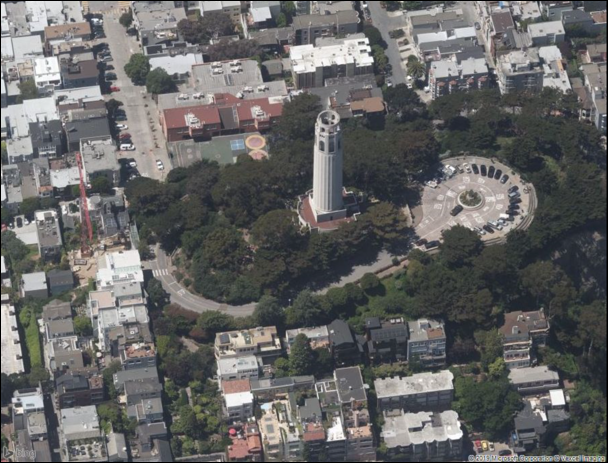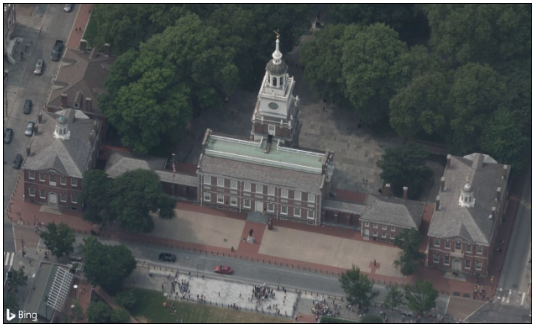The Bing Maps team continues to release more stunning high-resolution oblique (45-degree angle) aerial Bird's Eye View but did you know that you can leverage it to create experiences in your applications?
Bird's Eye Image available on Bing.com/Maps
Not only is Bing Maps API’s Bird's Eye imagery available at bing.com/maps and is used in the 3D cities constructed in the Windows Map App as well as Microsoft FlightSim, but it's also available through the Bing Maps for Enterprise Developer Platform either using an SDK or directly calling a REST API as follows:
- Using a Bing Maps Control SDK
- Bing Maps Web Control for interactive JavaScript maps.
- Bing Maps Native Controls for interactive Android and iOS maps.
- Bing Maps Windows App UWP Control for interactive Microsoft Windows maps.
- Microsoft Garage Mixed Reality Maps SDK for interactive maps in Unity.
- Using a Bing Maps REST API
- Bing Maps REST Imagery Metadata API for direct tile access.
- Bing Maps REST Imagery Static Maps API for static maps.
As you can see, there’s a variety of ways for developers to bring this incredible Bird’s Eye view into applications for web and mobile. Learn more about the Bing Maps Platform and how to access these APIs and SDKs at Microsoft.com/maps.
Location Data, Visualized Using The Imagery API
Every facet of the versatile Bing Maps API platform, including Bird’s Eye, is powered by a database of high-res imagery. Whether you’re looking for a hotel using Streetside or just sightseeing with Bird’s Eye, our extensive location data allows you to view the finer details without losing out on resolution. Bing Maps’ Imagery API makes it possible for developers of all skill levels to access both static and satellite imagery with just a simple URL request.
https://dev.virtualearth.net/REST/V1/Imagery/Map/Birdseye/37.802297,-122.405844/20?dir=270&ms=900,700&key={BingMapsKey}
This Bird’s Eye angle imagery request includes the desired coordinates, as well as a specified zoom level. Bing Maps API developers can also specify different levels of Bird’s Eye resolution for a customized viewing experience. In this case, we’ll be working with a 900px700p tile. This request will return the following image:

Bird's Eye Image available using Bing Maps Imagery API
Fetching Bird’s Eye Metadata With Bing Maps API
It’s also just as easy to delve deeper into a particular location’s metadata. Learn about where, when, and how an image was taken at any given point with a single request. Here’s what a typical response from the Imagery API would look like in JSON.
{
"__type": "ImageryMetadata:http://schemas.microsoft.com/search/local/ws/rest/v1",
"imageHeight": 256,
"imageUrl": "http://ecn.{subdomain}.tiles.virtualearth.net/tiles/r{quadkey}.jpeg?g=6644&mkt={culture}&shading=hill",
"imageUrlSubdomains": [
"t0",
"t1",
"t2",
"t3"
],
"imageWidth": 256,
"imageryProviders": null,
"vintageEnd": null,
"vintageStart": null,
"zoomMax": 21,
"zoomMin": 1
}
Fields like ‘vintageStart’ will provide the earliest available date for a given tile of imagery, while ‘vintageEnd’ denotes the latest available date. The other fields mainly correspond to the physical qualities of the image, such as zoom level and resolution. These details add another level of insight to an already unique Bird’s Eye angle.
Keep in mind that the resource returned by the API will depend on the nature of the request. Viewing a Bird’s Eye request might look different from a Streetside request, depending on the resources involved. This feature is useful for developers who want to make sure what they’re looking at is up to date, and also has applications for surveying and business research.
Enhanced Web Mapping
Gone are the days when developers had to deal with the bulky file sizes and slow load times that came with working on high-res imagery. Bing Maps API integrates its repository of Bird’s Eye angle location data with a resourceful web control that allows for fast load times.
V8 Web Control is the developer’s entry point into simplified web mapping. You’ll be able to create fast-loading web apps powered by the HTML5 grid canvas. This ensures fast load and view times, even when working with Bird’s Eye imagery, as well as animated tile layers and heat maps. Convenience is also prioritized here, as web based experiences offer seamless development across multiple browser-hosting platforms such as:
- Desktop: Windows, Linux and Mac
- Mobile Tablets and phones: Surface, iOS and Android
- Or any other device with a Modern HTML 5 browser
With customizable dimensions and fast rendering, there’s no limit to what Bing Maps API developers can achieve with a Bird’s Eye angle.
Developing With Bird’s Eye View
Kickstart your app with Bing Maps API’s focused developer support features. Our interactive SDK has interactive code snippets you can paste into your projects and our sample site shows tutorial code with full code available on github to encourage experimentation and creativity on your part. You’ll also find samples for other useful complementary features such as Streetside and spatial data services.
Bird's Eye v2 Image available on Bing Maps Interactive SDK
With the availability of free documentation, code samples, and a popular Bing Maps forum, developing with Bird’s Eye has never been easier.
Accessing this latest batch of high-res Bird’s Eye imagery is as easy as creating a Bing Maps API key. Create yours and get started with development right away.
- The Bing Maps Team


